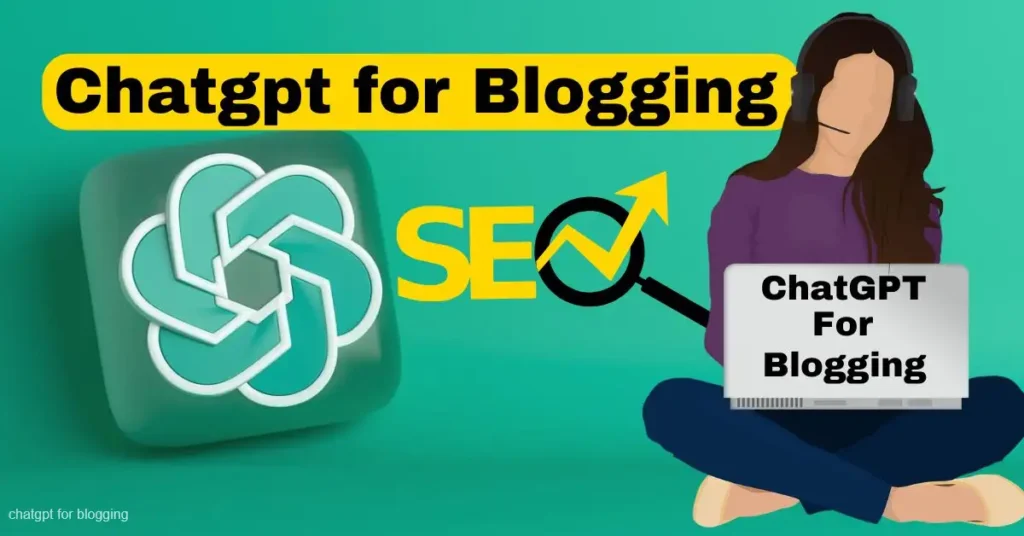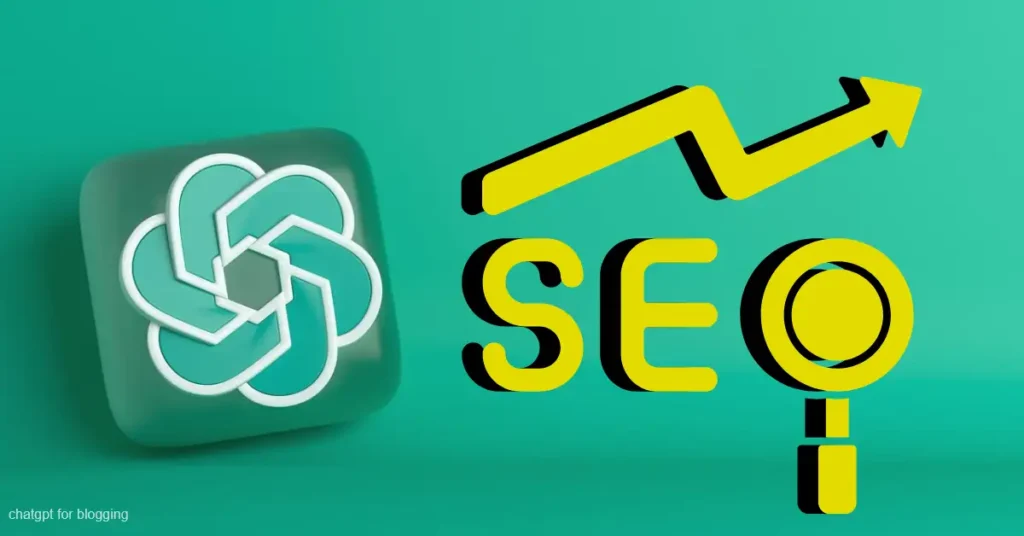Learn how to use ChatGPT for blogging with the best prompts to optimize your blog. Boost your content creation, SEO, and audience engagement effectively.
1. Introduction – ChatGPT for Blogging
ChatGPT is an advanced AI tool that can help you create high-quality content for your blog. Whether you’re struggling to come up with fresh ideas or need help writing entire blog posts, ChatGPT can assist you every step of the way. It’s like having a helpful assistant who can brainstorm ideas, write drafts, and improve your existing content.
In this guide, we will show you how to use ChatGPT for blogging and introduce you to the best prompts that will help optimize your blog. By the end of this post, you’ll know exactly how to make the most of this tool to improve your writing and enhance your blog’s SEO.

As a blogger, creating consistent and engaging content is key to growing your audience. With ChatGPT, you can save time and effort while still producing high-quality posts. It’s an excellent tool that can help you grow your blog and keep it fresh with new ideas and writing.
In this article, we’ll explore everything from getting started with ChatGPT to the specific prompts you can use to make your blog posts stand out. Let’s dive into how ChatGPT can be your new blogging partner.
2. Getting Started with ChatGPT for Blogging
The first step in using ChatGPT for blogging is signing up for an account. Once you have access, you can start chatting with the tool right away. ChatGPT is simple to use. All you need to do is type in a question or instruction, and it will respond with helpful information.
After signing up, you can begin interacting with ChatGPT by providing prompts or requests. For example, if you want a blog post about a specific topic, you can ask ChatGPT to write it for you. The key to getting good results is being clear about what you want. ChatGPT can help with everything from creating ideas to writing complete articles.

You can also set up ChatGPT to match your writing style. Whether you want it to be written in a formal tone or something more casual, ChatGPT can adjust it to suit your needs. This flexibility makes it an ideal tool for bloggers who want to maintain their unique voice.
Once you start using ChatGPT, you’ll see how easy it is to produce content quickly. It’s like having a writing assistant that can generate ideas and text whenever you need them.
3. Benefits of Using ChatGPT for Blogging
One of the main benefits of using ChatGPT is the time it saves you. Writing a blog post can take hours, but ChatGPT helps you get started in just minutes. Whether you need an entire article or just a few paragraphs, ChatGPT speeds up the process, allowing you to focus on other important tasks.
Another key benefit is that ChatGPT can help you overcome writer’s block. ChatGPT can suggest new ideas or even generate a full outline for your blog if you’re stuck and don’t know what to write about. This is especially helpful for bloggers who need to come up with fresh content regularly.

Using ChatGPT also improves your blog’s SEO. The tool can generate keyword-rich content that can help your blog rank higher in search engines. By including the right keywords and phrases, you can reach a wider audience and attract more visitors to your blog.
Lastly, ChatGPT’s ability to create engaging and well-structured content means you don’t have to worry about formatting. Whether you’re writing a detailed post or a quick update, ChatGPT ensures your content is clear, concise, and easy to read.
4. Top Use Cases for Bloggers
ChatGPT is incredibly versatile, and bloggers can use it in many ways. One of the most common uses is writing full blog posts. If you’re pressed for time or need help with ideas, you can ask ChatGPT to write a detailed post on your chosen topic.
In addition to writing posts, ChatGPT is great for generating blog outlines. If you know the topic but don’t know where to start, you can ask ChatGPT for an outline, and it will give you a structured plan to follow. This saves you from having to think of every single detail yourself.
Another useful feature is creating engaging headlines. ChatGPT can suggest multiple catchy headlines that will grab the reader’s attention. Since the title is the first thing people see, having a strong headline can help attract more clicks to your blog.
ChatGPT can also assist with social media posts. Once your blog post is ready, you can use it to create quick social media captions or summaries to promote your blog. This helps you stay consistent and save time on content creation across different platforms.
How to generate content using ChatGPT
To generate content using ChatGPT, they’ve also provided a promo for SEO-friendly content below. However, I will create a full promotional section and include it inside the article. If you follow this program, I will explain everything in detail, and I’ll keep updating it from time to time.
5. Best Prompts to Use for Blogging
When using ChatGPT for blogging, the prompts you give will determine the quality of the output. Here are a few examples of prompts to help you get started. For content creation, you can say, “Write a 1000-word blog post about [topic].” This will give you a detailed and well-structured article.
If you want help with your introduction, you can prompt, “Write an engaging introduction for a blog about [topic].” ChatGPT can help you craft a captivating opening that draws readers in and keeps them interested throughout the post.

To optimize your content for SEO, try using prompts like, “Suggest 10 SEO keywords for [topic] based on current trends.” This helps ensure your blog is optimized for search engines. Additionally, you can ask ChatGPT to write a meta description, which is important for improving your SEO rankings.
If you need help with editing, you can say, “Make this paragraph more engaging: [text].” ChatGPT will suggest ways to improve your writing, making it more readable and enjoyable for your audience.
6. Tips for Optimizing Your Prompts
To get the best results from ChatGPT, it’s important to optimize your prompts. The clearer your instructions, the better your output will be. Instead of vague requests like “write a blog post,” be specific about what you need. For example, “Write a blog post about [topic] with a friendly tone and 3 key takeaways.”
Another important tip is to provide context. Let ChatGPT know who your target audience is and what the goal of your post is. This helps the tool tailor its responses to your needs, ensuring your content resonates with your readers.
Also, don’t be afraid to ask for revisions. If the first response isn’t exactly what you were hoping for, you can always ask ChatGPT to make changes. For example, you can ask it to write in a different style or add more details to a specific section.
Finally, use ChatGPT in small steps. Instead of asking for a full post all at once, break it down. Ask for an outline, then the introduction, then the body, and finally the conclusion. This will help you guide the AI and get better results.
Final Article Prompt
Write a detailed, informative article of at least 5,000 words on “Insert Title Here.” The article should cover everything from the basics of “keywords” to advanced strategies. Include engaging and easy-to-understand language for beginners and technical terms for experienced advertisers. Address common questions about “keywords,” offer pros and cons, and provide practical advice with real-world examples and case studies. Each section should be well-researched, and informative, and include SEO-optimized “keyword” like “keyword,” “keyword,” and “keyword.” Additionally, follow Google’s SEO guidelines and ensure that the content is AdSense-friendly, with bullet points and sections like FAQ to increase reader engagement.
7. Common Challenges and How to Overcome Them
While ChatGPT is a powerful tool, it does come with some challenges. One common issue is that the content might feel generic. This happens because ChatGPT uses patterns from its training data, which can sometimes result in less original content. To overcome this, you can add your personal touch to the text, making it unique and more aligned with your style.
Another challenge is finding the right balance between using AI and your creativity. Relying too heavily on ChatGPT might make your content feel less authentic. The key is to use ChatGPT as a starting point or assistant, but make sure to add your voice and personality to the final piece.
Some bloggers might also struggle with keeping the content on track. If your prompt is too broad or unclear, ChatGPT might produce content that doesn’t align with your vision. To fix this, make your prompts more specific and adjust them based on the results you get.
Lastly, keep in mind that ChatGPT is a tool, not a replacement for creativity. Use it to streamline your process, but make sure the content still reflects your unique perspective and expertise.
8. SEO with ChatGPT
SEO is a crucial part of blogging, and ChatGPT can be a valuable asset for boosting your SEO efforts. To start, you can ask ChatGPT to help you find keywords related to your topic. For example, “What are the most searched keywords for [topic]?” This will give you valuable keywords to include in your blog post to help it rank better on search engines.
Once you have your keywords, ChatGPT can help you incorporate them naturally into your blog post. Instead of stuffing keywords, ChatGPT will suggest ways to use them in a way that flows well and doesn’t interrupt the reader’s experience.

You can also use ChatGPT to create SEO-friendly headings and subheadings. These are essential for breaking up your content and making it easier for readers to scan. For example, you can prompt, “Write SEO-friendly headings for a blog about [topic].”
Lastly, ChatGPT can help with meta descriptions, which are the short text snippets that appear in search results. A well-written meta description can improve your click-through rates, and ChatGPT can create one for you in seconds.
9. Real-Life Examples of Successful Blogging with ChatGPT
Many bloggers are successfully using ChatGPT to grow their blogs. For example, a food blogger used ChatGPT to help brainstorm recipe ideas and create blog posts more efficiently. This allowed them to post new recipes regularly without sacrificing quality.
Another blogger in the travel niche used ChatGPT to help write engaging guides and itineraries. By using ChatGPT for research and content creation, they were able to provide their audience with more in-depth and helpful posts.
These examples show how ChatGPT can be used across different blogging niches. Whether you’re writing about technology, fashion, or health, ChatGPT can save you time and help you produce better content.
By looking at these real-life examples, you can see how ChatGPT can be a valuable tool for bloggers. It’s not just about writing; it’s about creating high-quality, engaging content that your audience will love.
Can I use ChatGPT for blogging?
Yes, you can use ChatGPT for blogging, but it’s important to do so in a smart way. It’s not enough to simply write; you need to first create a solid structure for your content. Then, you must explain each point clearly.
Your article should outline the key concepts in a way that’s easy to understand. For example, you should explain things step by step, showing how to approach each section. When you do this, your article will be well-written, and you can successfully blog using ChatGPT.
As for me, I manage several websites, and all the content on these sites is created using ChatGPT. Our goal is to drive traffic from platforms like Google Discover. If you blog properly with ChatGPT, your posts will have a much better chance of ranking on Google.
If you provide a well-structured article and present it, whether you call it a blog post or article, it will be more effective. The better you write, the more likely it is that your content will rank higher in search engines like Google.
Will ChatGPT content rank on Google?
Yes, if you use ChatGPT to write your content, it will rank more easily on Google. ChatGPT is an advanced AI tool that helps you create content that can rank on Google and even appear on Google Discover.
However, here’s an important tip: the more detailed information you provide to ChatGPT about your article, including information related to your competitors, the better the content will be. This will increase your chances of ranking higher both on Google Search and Google Discover.

Does Google reject AI content?
Whether you use AI or not, it is not completely against Google’s guidelines. But here’s an important point: If you use AI to create blog posts, then the important thing is that your blog post should be engaging.
It should help the user who searched for it by reading this blog post. That is, if you have written unnecessary information, then your blog post should be like this.
If you write such blog posts, Google will not have any problem with it. You can write. You can also do this automation using AI. You will not have any problem with it.
Will AI replace jobs in 2025?
No, it’s not true that AI will take away your jobs. If you learn to communicate with AI and work alongside it, the number of jobs has increased.
Where there were once 87 million jobs, now there are 97 million, meaning there are far more job opportunities available.
And let me add one more thing: AI is trained by humans, right? If no human trains AI, how would it function? The idea that AI will replace everything is too simplistic.
You need to understand this better. If you’re interested, I can write a detailed post about it, where I’ll explain everything about AI—from its origins to where it is today and what has happened along the way. I’ll cover it all.
How to improve website rankings with AI
Yes, of course, you can improve your website’s ranking through AI in Google and other search engines. However, I want to let you know that I’ve already written a comprehensive article on this topic. I’ll provide you with the link, and all you need to do is click on it to find the information. Go ahead and read it. In the article, I’ve listed several AI plugins that can help boost your ranking.
Will Google Discover be included in ChatGPT Content?
Yes, you can enable Google Discover on your ChatGPT content. In addition, you can also enable Google News. However, to get your content featured on Google Discover, you need to focus on high-quality editing.
This means that the image on your page should be SEO-optimized, and your content should be between 600 to 700 words. It’s important not to exceed this word count, as longer posts have a lower chance of appearing on Google Discover.
You must also use a high-quality image. First, design an image, and then use a tool like Image Optimizer, which I’m providing a link to.
This tool will help you optimize your image for Google Discover. It maintains the image quality while ensuring it’s properly optimized, increasing the chances of your content being featured.
10. Conclusion and Call to Action
In conclusion, ChatGPT is an incredible tool for bloggers looking to save time and enhance the quality of their content. By using the right prompts, you can generate fresh ideas, write detailed posts, and optimize your blog for SEO.
Now that you know how to use ChatGPT for blogging, it’s time to start experimenting with different prompts. Don’t be afraid to try new things and see what works best for your blog. The more you use ChatGPT, the more you’ll learn how to tailor it to your needs.
Start by using ChatGPT for small tasks like generating headlines or outlines. As you get more comfortable, you can use it to write entire posts or optimize existing content. Remember, ChatGPT is your assistant, not a replacement for your creativity.
Take action today and start using ChatGPT to improve your blogging process. With a little practice, you’ll be able to create content faster and more effectively, leading to a stronger and more successful blog.
FaQ’s- ChatGPT for Blogging
Can earn $10,000 by blogging with ChatGPT.
Yes, you guys can earn that much money every month with ChatGPT. That means earning $10,000 is nothing. Friends, you can earn more than that using ChatGPT.
Do pro bloggers with ChatGPT?
Yes, absolutely, there are pro bloggers with ChatGPT, which provides you with content, analyzes the first information available on the internet, and then shares the content with you in a unique way.
My name is M. Ali Sher. I am from Pakistan. I work on blogging, SEO, WordPress, and many other topics. I have about two years of experience in this field. All the information on this website related to blogging, SEO, WordPress, and Earning Money online is my personal experience. I have published many tools on this site, and some are yet to be released. They will also be available on this website soon. I have been working in blogging and SEO for a long time and as I told you, I have a lot of knowledge about it, so I want to share my knowledge with you. So that you guys can also start earning money from blogging and SEO.


